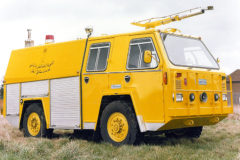Caterpillar D9 cable dozer
Posted by Chris Graham on 17th May 2021

Caterpillar D9 cable dozer: Showing the scale of this impressive machine, David and Janki pose with their handiwork.
Sandstone Heritage Trust has a very useful collection of earth-moving equipment, with one of the highlights being a Caterpillar D9 cable dozer, but also includes Foden dump trucks, an old Case TLB from the 1970s, two Ruston Bucyrus excavators and other items. However, it’s the Caterpillar dozer collection that we’re concentrating on this time.
There are D2, D4, D6, D7, D8 and D9 dozers currently in the collection, and the latest of these is the most interesting; our 1950s Caterpillar D9 cable dozer that was obtained from the estate of the late Zach van Staden, in Bloemfontein.
Zach was a great supporter of Sandstone, and was the man responsible for building the initial, 2ft narrow-gauge railway. He built the section from the main complex all the way to Vailima, and also constructed the two dams – the Railway Dam and the Pandora Dam – over which the railway passes. Without the railway, there wouldn’t have been dams there.

Janki working on the Caterpillar D9 cable dozer.
Zach, although retired from active engineering contracting work, was an avid collector, and he used his collection of old earth-moving machinery to build the railway. In his later years, he was more than happy to make the old machines available to Sandstone, and many of the items in our collection came from him.
Following his death, an auction was held at his premises, but the reserves placed on individual items are too high for us to contemplate buying them. However, as a result of subsequent negotiations, we managed to purchase the very old Cat D9 cable dozer, which was still in running condition as it is now. Once it fell under the care and attention of Deon Muller, our wonderful Caterpillar-trained mechanic, things started to look up.
Having sorted out the mechanical side of things, it was transferred to Janki Palmer’s spray-painting and panel-beating division at Sandstone Estates, within the Sandstone main workshops. The photographs here show David, a master craftsman in this area of speciality, working on the dozer with Janki.
The D9 was a series of heavy, tracked-type tractors, carried on continuous tracks and usually used as bulldozers. The series began in 1954, with a prototype tractor called the D9X. Ten D9X prototype models were built in 1954. Then, in 1955, the 286hp D9 was introduced to compete against the more powerful Euclid TC-12.

The D9 came equipped with a 1,473cu in D353, which powered it until the D9L was introduced in 1980. The D9L unit featured the same, new type of elevated drive sprocket undercarriage as had been introduced on the larger D10, in 1977. The new undercarriage design reduced strain and shock loads on the final drives, and gave the ‘belly pan’ more ground clearance.
The final design of the D9 production model incorporated suggestions from customers involved in the pilot test program. The first production D9 – and the first new, track-type tractor produced by Caterpillar since 1938 – came off the assembly line in April 1955. At that time, it was the world’s largest and most powerful tractor, weighing more than 56,000 pounds and powered by a 286hp, turbo-charged engine. Additional features included a standard torque converter transmission, oil-type clutch, in-seat starting, excellent operator visibility and many servicing conveniences that were previously not available in Caterpillar’s product line.
In 1956, the D9 had its engine power raised to 320hp, then the new 335hp D9E replaced that model in 1959. Two years later, the legendary 385hp D9G was introduced; it remained in production for 13 years, and became the main crawler on many job sites, testifying to its sturdiness and design quality.
Today’s D9 – the D9T – has a reputation for outstanding productivity, operator comfort and robust reliability. It’s a highly versatile machine that’s flexible enough to be used in heavy construction, quarries, landfills, forestry and mine sites.
For a money-saving subscription to Old Glory magazine, simply click here





